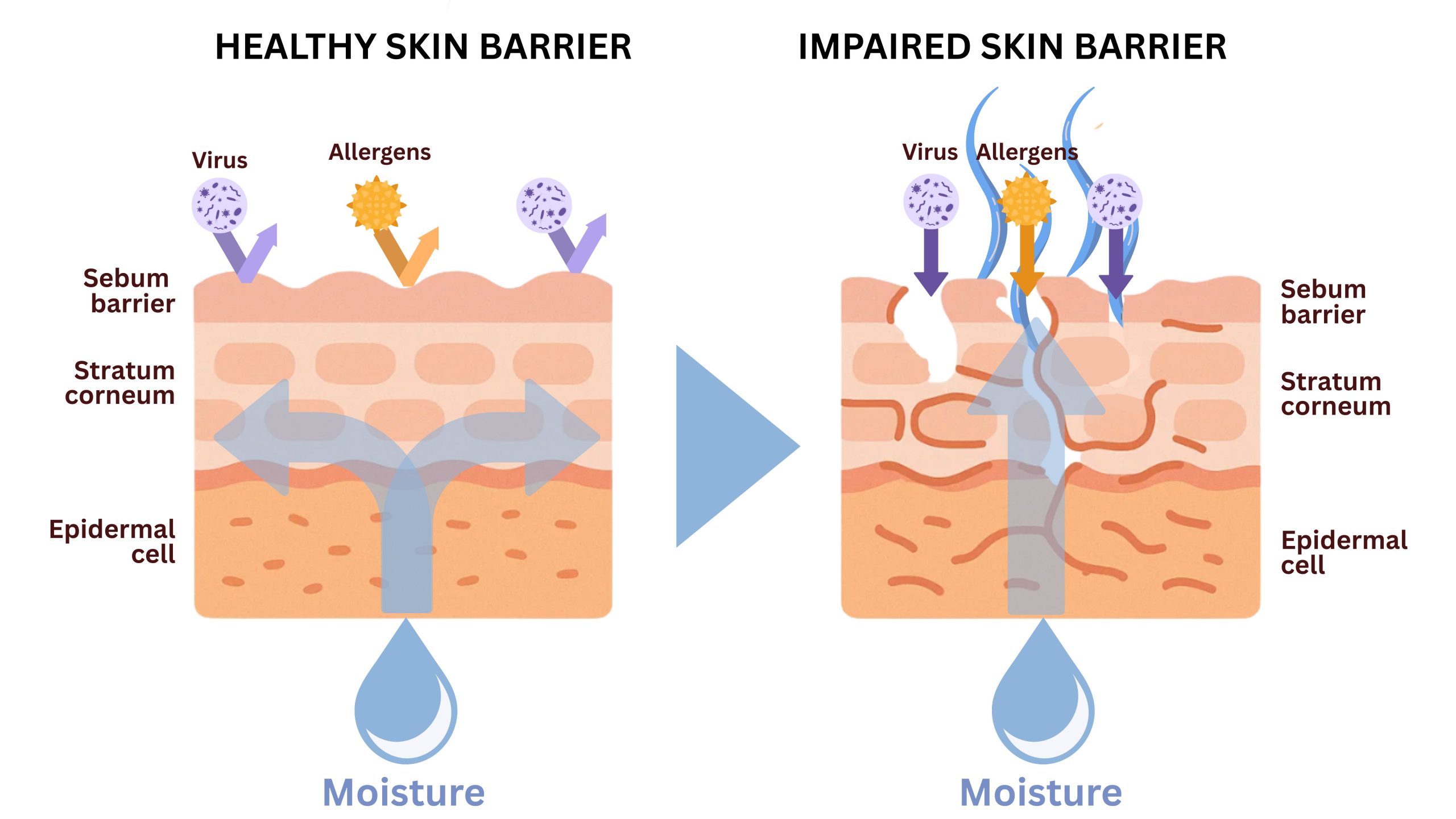When your barrier is stressed, symptoms may include dryness, tightness, flaking, redness, inflammation, increased sensitivity, acne breakouts, eczema flare-ups, infections, and even hyperpigmentation. If you notice persistent irritation or dullness, your skin barrier may be weakened.
We rarely think about it, but the importance of our skin barrier can’t be overstated as it’s the unsung hero that keeps moisture in, toxins out, and your complexion glowing. In this blog post, we’ll show you how to spot when it’s failing, and arm you with the tools to nurture your skin’s frontline defense — because flawless skin begins with a barrier that works as beautifully as it looks.

When beauty editors and dermatologists talk about the “skin barrier,” they’re usually referring to the epidermal permeability barrier, more specifically the stratum corneum, the outermost layer of your skin. The stratum corneum can be seen as a brick-and-mortar structure: the “bricks” are the corneocytes (dead, flattened skin cells), and the “mortar” is a matrix of lipids (ceramides, cholesterol, and free fatty acids) that hold everything together.
The skin barrier is dynamic, not static. It regulates what passes in and out. When functioning optimally, it allows measured amounts of water to escape while blocking harmful pathogens, irritants, and pollutants. Deeper layers of the epidermis and tight junctions help regulate vital nutrient transport and maintain cohesion. But the stratum corneum remains the first line of defense against external aggressors. In short, the skin barrier is your skin’s frontline worker: it controls hydration, defends against environmental stressors, and maintains balance.

The skin’s outer layer, called the epidermis, acts like a protective shield. It constantly renews itself and keeps harmful germs and irritants out while locking moisture in. A big part of this defence system is the “acid mantle” — a very thin, slightly acidic film on the skin’s surface. This acidity is essential because it keeps the skin barrier strong, supports healthy bacteria, and prevents bad bacteria like Staphylococcus aureus from taking over. When the skin becomes too alkaline — which can happen with ageing, frequent washing with harsh soaps, or in certain skin conditions — its barrier weakens. This can lead to dryness, irritation, infection, or flare-ups like eczema.
If the barrier is compromised, your skin’s equilibrium shifts, leading to the start of a plethora of skin problems. Understanding the importance of your skin barrier means appreciating its functions and all the tasks it performs.
Our skin barrier houses immune cells such as Langerhans cells, resident T cells. These cells survey for invaders and modulate inflammatory responses. When the barrier is intact, it prevents exaggerated immune activation. However, when it’s compromised, inflammatory pathways can be triggered.
Thus, the barrier’s functions all come together to support and protect your skin. Hydration control, defense, immune signaling, and microbiome balance all anchor back to that fortress-like outer layer. As one review put it, “(the) compromise of epidermal barrier function is commonly associated with several dermatologic disease states.”

When your barrier is stressed, symptoms may include dryness, tightness, flaking, redness, inflammation, increased sensitivity, acne breakouts, eczema flare-ups, infections, and even hyperpigmentation.
Because the barrier’s defenses are down, allergens are able to penetrate and trigger immune responses more easily, including lashes in sensitisation.
When you see persistent skin tightness, sensitivity to products, or flare-ups you can no longer tame with your regular routine, it’s time to ask: is my skin barrier compromised?
When we think about ageing, fine lines and sagging are culprits that come to mind first. But the true story of youthful radiance starts at the surface — with the skin barrier. The importance of skin barrier health cannot be overlooked, particularly as we age. A strong barrier is not only essential for hydration and resilience but also for slowing down the visible signs of ageing. As this protective shield weakens over time, skin becomes more vulnerable to dryness, sensitivity, inflammation, and environmental damage.
The skin barrier is central to how youthful, plump, and resilient your skin looks and feels. With each decade, changes occur that compromise its ability to protect and repair itself. These age-related shifts accelerate the visible signs of ageing.
Lipids such as ceramides, cholesterol, and free fatty acids act as the mortar between skin cells, preventing moisture loss and keeping irritants out. With age, lipid production declines, weakening this structure. Increased transepidermal water loss (TEWL) leaves mature skin chronically dry, tight, and less elastic — one of the first hallmarks of barrier ageing.
In youthful skin, the barrier bounces back quickly after disruption. But in ageing skin, keratinocyte turnover slows and lipid replenishment takes longer. This sluggish recovery means even minor stressors — like cold air or over-exfoliation — can trigger lasting irritation or sensitivity.
The NMF, made up of amino acids, urea, and lactates, attracts and retains water in the stratum corneum. With age, NMF levels fall, leaving skin unable to hold moisture. This leads to crepey texture, fine dehydration lines, and an overall dull appearance.
The health of your skin barrier plays a vital role in how youthful and radiant your skin looks. As we age, natural changes occur that compromise its ability to protect and repair. This leads to dryness, loss of elasticity, fine lines, dullness, and increased sensitivity. Lipid depletion, reduced natural moisturising factors, slower barrier recovery, and shifts in the microbiome all accelerate visible ageing.
As the barrier thins, it struggles to block allergens, pollutants, and harsh ingredients. This is why mature skin often becomes more reactive, with redness, burning, or stinging reactions more common.
The barrier provides limited protection against UV and oxidative stress. With age, this protection weakens, allowing UV rays and pollutants to penetrate more deeply. The result is faster collagen breakdown, pigmentation irregularities, and premature fine lines — all signs of photoageing.
Proteins like filaggrin, which help to maintain corneocyte cohesion and generate NMF, decline with age. Reduced filaggrin weakens hydration and surface smoothness, making skin appear rougher and less radiant.
An impaired barrier allows irritants and microbes to seep in, triggering immune responses. Ageing skin struggles to switch off this response, leading to chronic low-grade inflammation, or “inflammaging.” This accelerates collagen degradation, pigmentation problems, and skin fragility.
When the barrier weakens, the signs are hard to ignore. Examples include the following:
All in all, your skin barrier is the canvas of your complexion. If the canvas frays, no amount of dermal support from collagen and elastin can fully restore your youthful glow.
The good news is that the impairment of our skin barrier is not inevitable. With the right care, you can reinforce your barrier and slow age-related changes. Here are proven strategies to protect the skin barrier and maintain younger looking skin.
Choose moisturisers formulated with ceramides, cholesterol, and fatty acids. These directly replace what skin loses with age, helping to restore the barrier’s structural “mortar” which holds the skin cells intact to prevent damage to skin barrier.
Look for humectants such as hyaluronic acid, glycerin, and sodium PCA, which draw in water and combat dehydration lines in ageing skin.
Support the Skin microbiome with a diet that contains prebiotics, probiotics, and postbiotics. Opt for microbiome-friendly skincare with prebiotics and postbiotics. Gentle, fragrance-free formulas help to restore balance, reduce irritation, and support your skin barrier resilience.
Do not overuse potent active ingredients such as retinoids and exfoliants. Although these ingredients deliver anti-ageing benefits, they can stress a weakened barrier. Prioritise barrier repair first, then introduce more aggressive skincare gradually, buffered with hydrating layers.
Sun protection is the most effective anti-ageing step. Choose broad-spectrum mineral sunscreens enriched with antioxidants to both protect the barrier and reduce photoageing.
Plant oils rich in Omega-3 and Omega-6 such as that of chia seeds, evening primroses, and sunflowers reinforce the lipid matrix. Antioxidants like vitamin E, coenzyme Q10, and green tea extract fight oxidative stress that accelerates barrier breakdown.
Ingredients such as niacinamide, panthenol, and oat extract soothe inflammation, reduce redness, and allow the skin barrier to repair itself without chronic irritation.
The importance of your skin barrier in slowing down the signs of ageing goes far beyond hydration. It is the foundation of healthy, youthful skin. By nurturing your barrier with barrier-friendly skincare, microbiome support, and daily sun protection, you not only repair present damage but also future-proof your complexion against time.
Your skincare shouldn’t just fight wrinkles — it should reinforce the invisible shield that makes radiant skin possible.
Caring for your skin barrier goes beyond just choosing the right products — it’s about adopting treatments and routines that actively reinforce its resilience. Whether you’re dealing with premature ageing, sensitivity, or simply dryness, these barrier-focused treatments can help restore balance and vitality.
Formulations packed with ceramides, cholesterol, and fatty acids mimic the skin’s natural lipid matrix, helping to rebuild and fortify the barrier.
Humectants such as hyaluronic acid and glycerin deliver deep hydration, plumping the skin and reducing the appearance of fine dehydration lines.
Soothing agents like niacinamide, panthenol (Vitamin B5), oat extract, and allantoin help calm irritation, reduce redness, and accelerate barrier repair.
Topical antioxidants — Vitamin E, Coenzyme Q10, and green tea extract — protect the barrier from oxidative stress and pollution, while also supporting skin repair mechanisms.
Probiotic and prebiotic skincare supports the skin’s microbiome, helping to restore balance and promote long-term barrier health.
Intensive therapies such as hydrating facials, LED light therapy (for calming inflammation), or lipid-rich infusions can provide an extra boost for compromised or ageing barriers.
The barrier is the canvas of your complexion. No matter how strong your dermal scaffolding is, an ageing barrier makes skin appear lacklustre.
Your skin barrier is the foundation of healthy, youthful skin. By protecting it with the right products, lifestyle choices, and professional treatments, you can future-proof your complexion against time. True radiance doesn’t come from serums alone; it starts with safeguarding the natural skin shield that keeps our skin healthy and resilient.
LA SOURCE SPA
Thank you for contacting La Source Spa. How can we assist you today?
Are you making enquiry about Correlation Between Skin Barrier and Ageing?
WhatsApp Us
Online | Privacy policy
Chat Now